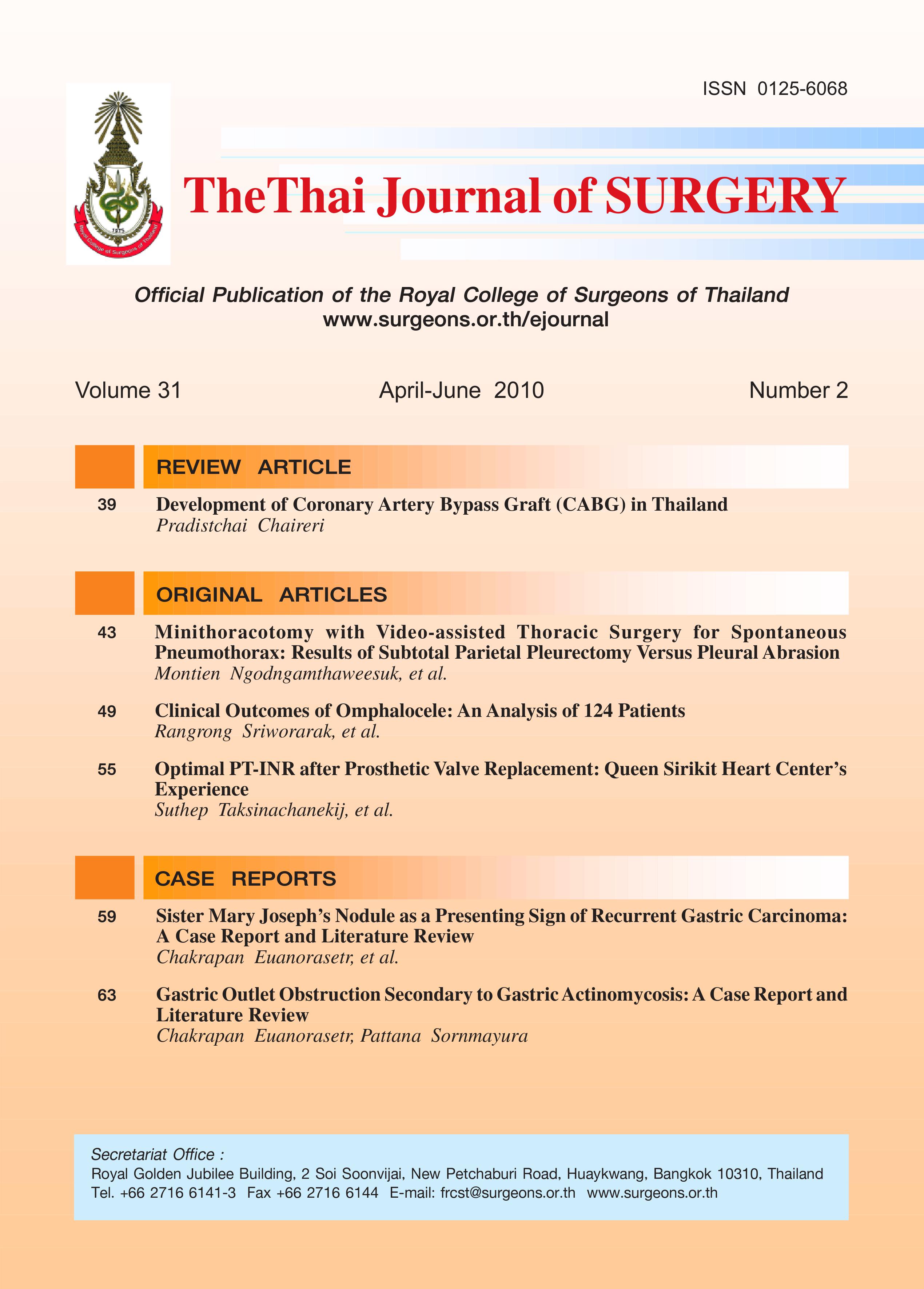Clinical Outcomes of Omphalocele: An Analysis of 124 Patients
Keywords:
abdominal wall defect, congenital anomalies, omphaloceleAbstract
Background: Omphalocele is defined as an anterior midline defect of the abdominal wall through whichvarious viscerae herniated into an avascular sac. Currently, the mortality rate is not decreasing because of high
incidence of severe associated abnormalities.
Objectives: The aim of this study was to review long-term outcomes of patients with omphalocele in the
recent 10-year period.
Materials and Methods: Medical records of patients with omphalocele who were treated at the Queen
Sirikit National Institute of Child Health (QSNICH) during 1998-2007 were collected. Patient’s data including
demographics, modes and results of the treatment were collected and analyzed.
Results: One hundred and twenty-four babies were treated for omphalocele at the QSNICH during the
study period. An incidence of omphalocele among neonates born at the Rajavithi hospital was about 1:2,800 live
births. Sizes of the omphalocele defects ranged from 2 to 13 cm. in diameter (average 4.5 cm.). Musculoskeletal
and cardiovascular defects were the most common abnormalities in this study. Eight patients succumbed before
the definitive treatment. Twenty-two patients (17%) who had severe associated anomalies and suspected
incompatible with life were conservatively treated by topical antiseptic therapy. Only 2 of the 22 neonates (9%)
survived. Ninety-four patients were operated on and primary fascial closure was feasible in 61 cases (49%).
Forty-four of the 61 patients (72%) survived. The duration from closure to the first oral feeding ranged from
7 to 14 days. The remaining 33 neonates (27%) with omphalocele defect larger than 6 cm. in diameter were
managed by staged operations and only 21 patients (63.6%) survived. Of the total 124 patients, 67 cases
survived. The overall survival rate was 54%. Fifty-seven patients (41%) died because of severe associated
anomalies and related complications including sepsis, pneumonia and congestive heart failure.
Conclusions: The important factor which influences the mortality of omphalocele is severe associated
anomalies. The survival rate might be improved if these anomalies could be corrected.
References
editors. Neonatal surgery. 4th ed. London: Butterworths;
1990. p. 376-402.
2. Calzolari E, Bianchi F, Dolk H, et al. Omphalocele and
gastroschisis in Europe:a survey of 3 million births 1980-1990.
Am J Med Gen 1995;58:187-94.
3. Rankin J, Dillon E, Wright C. Congenital anterior abdominal
wall defects in the North of England, 1986-1996: occurrence
and outcome. Prenat Diagn 1999;19:662-8.
4. Gross RE, Blodgett JB. Omphalocele (umbilical eventration)
in the newly born. Gynecol Obstet 1940;17:520-7.
5. Ladd WE, Gross RE. Abdominal surgery of infancy and
childhood. Philadelphia: WB Saunders; 1941. p. 314-24.
6. Margulies L. Omphalocele (amniocele). Am J Obstet
Gynecol 1945;49:695-9.
7. Izant RJ, Brown F, Rothman BF. Current embryology and
treatment of gastroschisis and omphalocele. Arch Surg
1966;93:49-53.
8. de Vries PA. The pathogenesis of gastroschisis and
omphalocele. J Pediatr Surg 1980;15:245-51.
9. Gray SW, Skandalakis JE. Embryology for surgeons.
Philadelphia: WB Saunders; 1972. p. 387-441.
10. Duhamel B. Embryology of exomphalos and allied
malformations. Arch Dis Child 1963;38:142-7.
11. Axt R, Quijano F, Boos R, et al. Omphalocele and gastroschisis
: prenatal diagnosis and perinatal management, a case
analysis of the years 1989-1997 at the Department of
Obstetrics and gynecology, University of Homburg/Saar.
Eur J Obstet Gynecol 1999;87:47-54.
12. Forrester MB, Merz RD. Epidemiology of abdominal wall
defects, Hawaii 1986-1997. Teratology 1999;60:117-23.
13. Mabogunje OA, Mahour GH. Omphalocele and
gastroschisis: trends in survival across two decades. Am J
Surg 1984;148:679-86.
14. Gibbin C, Touch S, Broth RE. Abdominal wall defects and
congenital heart disease. Ultrasound Obstet Gynecol
2003;21:334-7.
15. Niramis R, Watanatittan S, Anuntkosol M, et al. Omphalocele:
results of the treatment in 115 neonates. J Int Coll Surg Thai
1998;41:15-21.
16. Havanonda S, Suwatanaviroj A, Watanatittan S, et al.
Omphalocele. In: Havanonda S, Sutthiwan P, Thitawat W, et
al, editors. Progress in Surgery Series of the Royal College of
Surgeon of Thailand Vol 3. Bangkok: Bangkok Medical
Publisher; 1983. p. 95-104 (in Thai).
17. Knight PJ, Sommer A, Clathworthy HW. Omphalocele: a
prognostic classification. J Pediatr Surg 1981;16:599-604.
18. Stringel G, Filler RM. Prognostic factors in omphalocele and
gastroschisis. J Pediatr Surg 1979;14:515-9.
19. Yazbeck S, Ndoye M, Khan AH. Omphalocele:a 25-year
experience. J Pediatr Surg 1986;21:761-3.
20. Cantrell JR, Haller JA, Ravitch MM. A syndrome of congenital
defects involving the abdominal wall, sternum, diaphragm,
pericardium and heart. Surg Gynecol Obstet 1958;107:620-
4.
21. Grosfeld JL, Dawes L, Weber TR. Congenital abdominal wall
defects:current management and survival. Surg Clin North
Am 1981;61:1037-49.
22. Campbell JJ, Campbell JR, Harrison MW. Selective
management of omphalocele. Ann Surg 1982;143:572-4.
23. Suita S, Sakaguchi T, Nakano H, et al. Significance of
antenatal diagnosis of omphalocele. Pediatr Surg Int 1992;
7:37-40.
Downloads
Published
How to Cite
Issue
Section
License
Articles must be contributed solely to The Thai Journal of Surgery and when published become the property of the Royal College of Surgeons of Thailand. The Royal College of Surgeons of Thailand reserves copyright on all published materials and such materials may not be reproduced in any form without the written permission.



